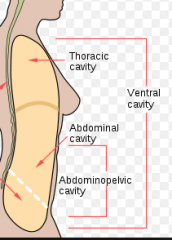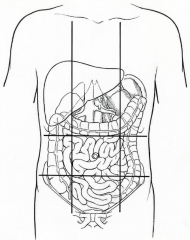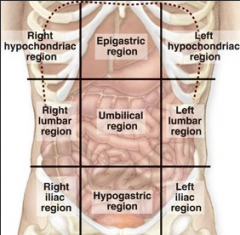![]()
![]()
![]()
Use LEFT and RIGHT arrow keys to navigate between flashcards;
Use UP and DOWN arrow keys to flip the card;
H to show hint;
A reads text to speech;
47 Cards in this Set
- Front
- Back
|
Anter(o)
|
Front |
|
|
Caud(o)
|
Tail, downward |
|
|
Cephal(o) |
Head, upward
|
|
|
Dist(o)
|
Away from |
|
|
Dors(o)
|
Back
|
|
|
Infer(o)
|
Below |
|
|
Later(o)
|
Side |
|
|
Medi(o) |
Middle |
|
|
Poster(o) |
Back, Behind |
|
|
Proxim(o) |
Near, Proximate |
|
|
Super(o)
|
|
|
|
Ventr(o)
|
Front, belly |
|
|
Anterior and Ventral are used when referring to :
|
The front of the body. ( Kneecap) |
|
|
Posterior and dorsal are used when referring to : |
The back of the body. ( Shoulder blades ) |
|
|
Cephalad and superior are used when referring to :
|
" Above the waistline " ( Hands) |
|
|
Caudal and Inferior are used referring to :
|
" Below the waistline " ( Feet ) |
|
|
Lateral is used when referring to : |
"Sides of the body" ( Little toe is on the side of the foot)
|
|
|
Medial is used when referring to "
|
The middle of the body. ( Middle toe is medial side of the foot)
|
|
|
Proximal is used when referring to:
|
" Closest " Center of the body or point of attachment. ( The proximal end of the femur joins the pelvic bone.) |
|
|
Distal is used when referring to:
|
" Farthest ". Outer part of the body or away from the point of attachment or orgin. ( Hand is located at distal end of forearm.) |
|
|
Superficial is used when referring to :
|
" On the surface" or " shallow ". ( Skin is superficial to the muscled. ) |
|
|
Intermediate is referring to :
|
" Between" or " Middle place". The abdominal muscles are intermediate between the small intestines and the skin. |
|
|
Deep refers to:
|
" Farther away from the surface" ( Abdominal muscles are deep to the skin. |
|
|
Unilateral refers to : |
Located " On only one side of the body" ( Liver, or stomach )
|
|
|
Bilateral refers to :
|
Located " On both sides of the body" ( arms, legs, eyes, kidneys.) |
|
|
Ipsilateral refers to :
|
Located " On the same side of the body." ( Right ear and eye )
|
|
|
Contralateral refers to :
|
|
|
|
What are the 3 BASIC anatomical planes?
|
Sagittal, Frontal ( Coronal ), Transverse
|
|
|
The Frontal ( Coronal ) Plane divides :
|
The body from front and back ( anterior and posterior ) |
|
|
The Sagittal Plane divides :
|
|
|
|
The Transverse Plane divides:
|
|
|

Which planes are A, B, and C?
|
B. Sagittal Plane C. Transverse Plane |
|
|
What are body cavities?
|
They are fluid-filled spaces that contain the internal, visceral or splanchnic body organs. |
|
|
What are the two major closed cavities of the human body?
|
The Dorsal and Ventral body cavities. |
|
|
The Dorsal body cavity is located where and contains what?
|

Posterior Region The cranial cavity and spinal cavity. |
|
|
The Ventral body cavity is located where and contains what/
|

Anterior Region The Thoracic Chest cavity, The Abdominopelvic Cavity. |
|
|
What are examples of smaller cavities?:
|
Nasal cavity, Oral cavity, Orbital cavities, Synovial cavities, Tympanic cavities. |
|
|
What are body REGIONS?
|
Body regions are areas of the body that perform special functions or are supplied by specific blood or nerve cells. |
|
|
The abdominal area is divided into how many regions?
|
9 |
|

|

|
|
|
Right Upper Quadrant ( gallbladder, liver) pain and tenderness is common in clients with:
|
|
|
|
Left Upper Quadrant ( Stomach, pancreas, spleen, left portion of liver), pain and tenderness is common in clients with :
|
|
|
|
Right Lower Quadrant ( Appendix, upper portion of colon, right ovary, right ureter, Fallopian tube) pain and tenderness is common in clients with :
|
Appendicitis.
|
|
|
Left Lower Quadrant ( Left ovary, left ureter, left fallopian tube ) pain and tenderness is common in clients with :
|
|
|
|
The spinal column is divided into how many regions?
|
5 |
|
|
What are the spinal column regions?:
|
T - Thoracic ( T1 - T12 or D1 - D12) L - Lumbar ( L1 - L5 ) S - Sacral Region ( S1 - S5) Coccygeal Region - the coccyx ( tailbone) |
|

|

|

